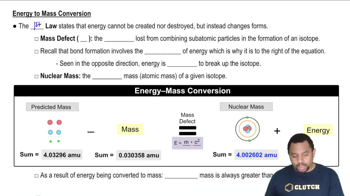Here are the essential concepts you must grasp in order to answer the question correctly.
Einstein's Mass-Energy Equivalence
Einstein's mass-energy equivalence principle, expressed as E=mc², states that energy (E) and mass (m) are interchangeable; they are different forms of the same thing. This principle is crucial for understanding how the Sun converts mass into energy through nuclear fusion, allowing us to calculate the rate of mass loss based on the energy output.
Recommended video:
Energy to Mass Conversion
Nuclear Fusion in the Sun
Nuclear fusion is the process by which two light atomic nuclei combine to form a heavier nucleus, releasing energy in the process. In the Sun, hydrogen nuclei fuse to form helium, which is the primary source of the Sun's energy. This process not only generates energy but also results in a gradual loss of mass, which can be quantified.
Recommended video:
Rate of Reaction and Particle Consumption
The rate of reaction in nuclear processes, such as those occurring in the Sun, can be determined by the energy produced and the number of particles involved. By knowing the total energy output and the energy released per fusion reaction, we can calculate how many protons are consumed per second, providing insight into the Sun's longevity and energy production.
Recommended video:
 Verified step by step guidance
Verified step by step guidance

